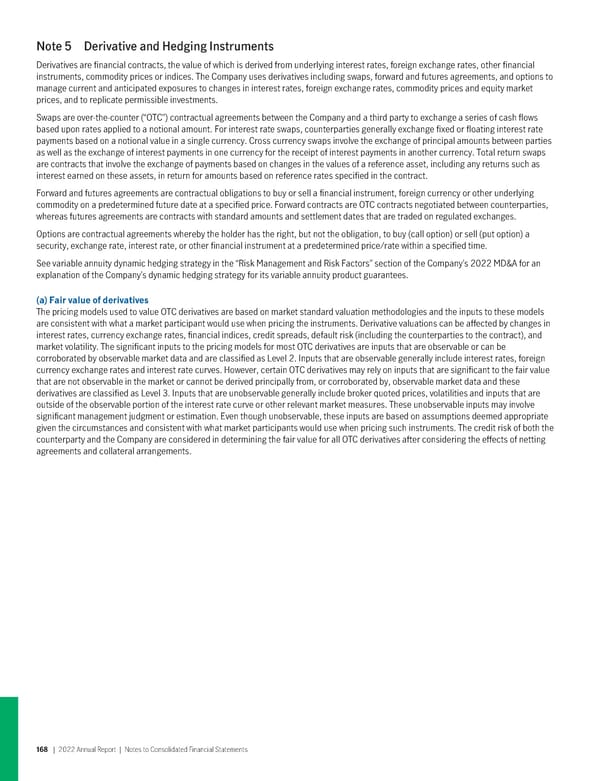Note 5 Derivative and Hedging Instruments Derivatives are financial contracts, the value of which is derived from underlying interest rates, foreign exchange rates, other financial instruments, commodity prices or indices. The Company uses derivatives including swaps, forward and futures agreements, and options to manage current and anticipated exposures to changes in interest rates, foreign exchange rates, commodity prices and equity market prices, and to replicate permissible investments. Swaps are over-the-counter (“OTC”) contractual agreements between the Company and a third party to exchange a series of cash flows based upon rates applied to a notional amount. For interest rate swaps, counterparties generally exchange fixed or floating interest rate payments based on a notional value in a single currency. Cross currency swaps involve the exchange of principal amounts between parties as well as the exchange of interest payments in one currency for the receipt of interest payments in another currency. Total return swaps are contracts that involve the exchange of payments based on changes in the values of a reference asset, including any returns such as interest earned on these assets, in return for amounts based on reference rates specified in the contract. Forward and futures agreements are contractual obligations to buy or sell a financial instrument, foreign currency or other underlying commodity on a predetermined future date at a specified price. Forward contracts are OTC contracts negotiated between counterparties, whereas futures agreements are contracts with standard amounts and settlement dates that are traded on regulated exchanges. Options are contractual agreements whereby the holder has the right, but not the obligation, to buy (call option) or sell (put option) a security, exchange rate, interest rate, or other financial instrument at a predetermined price/rate within a specified time. See variable annuity dynamic hedging strategy in the “Risk Management and Risk Factors” section of the Company’s 2022 MD&A for an explanation of the Company’s dynamic hedging strategy for its variable annuity product guarantees. (a) Fair valueof derivatives The pricing models used to value OTC derivatives are based on market standard valuation methodologies and the inputs to these models are consistent with what a market participant would use when pricing the instruments. Derivative valuations can be affected by changes in interest rates, currency exchange rates, financial indices, credit spreads, default risk (including the counterparties to the contract), and market volatility. The significant inputs to the pricing models for most OTC derivatives are inputs that are observable or can be corroborated by observable market data and are classified as Level 2. Inputs that are observable generally include interest rates, foreign currency exchange rates and interest rate curves. However, certain OTC derivatives may rely on inputs that are significant to the fair value that are not observable in the market or cannot be derived principally from, or corroborated by, observable market data and these derivatives are classified as Level 3. Inputs that are unobservable generally include broker quoted prices, volatilities and inputs that are outside of the observable portion of the interest rate curve or other relevant market measures. These unobservable inputs may involve significant management judgment or estimation. Even though unobservable, these inputs are based on assumptions deemed appropriate given the circumstances and consistent with what market participants would use when pricing such instruments. The credit risk of both the counterparty and the Company are considered in determining the fair value for all OTC derivatives after considering the effects of netting agreements and collateral arrangements. 168 | 2022AnnualReport | NotestoConsolidatedFinancialStatements
 2022 Annual Report Page 169 Page 171
2022 Annual Report Page 169 Page 171